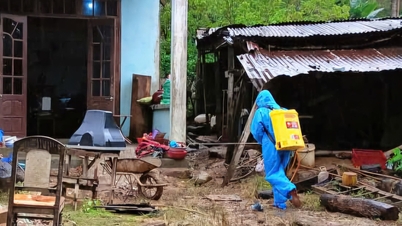
Increased flu cases
According to the records of pediatricians at Medlatec Thanh Xuan General Clinic, the number of children coming to the clinic and being diagnosed with influenza A is showing a clear upward trend. In the past week, the clinic has received an average of 20-30 pediatric cases per day, of which 70-85% of children were diagnosed with influenza.
Child D.TL (13 years old, Hanoi ) came to Medlatec Thanh Xuan Clinic for examination due to high fever.
At the clinic, L.'s family said: During the day, the child had intermittent fever, the highest temperature was 41 degrees Celsius. Although he took fever-reducing medicine, the response was slow, about 3-4 hours after each fever, the child was tired and had an increased cough, coughed up phlegm, did not cough, had a stuffy nose, clear runny nose, sneezed, and vomited little white phlegm.
In addition, the family added that the child was healthy and had not been vaccinated against the flu, while the father had just recovered from dengue fever, and several classmates also had fevers of unknown cause.
After examination, Master, Doctor Tran Thi Kim Ngoc - Pediatrics, Medlatec Thanh Xuan General Clinic recorded that the child had symptoms of respiratory tract inflammation syndrome: high fever, sneezing, stuffy nose, runny nose, cough. Listening to the lungs, there was good ventilation on both sides, no pathological rales were detected. No signs of respiratory failure or lung damage were recorded.
The doctor ordered L. to do tests to find the cause. The influenza A test result was positive. The ENT examination showed a swollen palate, fluid retention, hyperplasia of the posterior pharyngeal granulation tissue, congested mucosa, and phlegm in the posterior pharyngeal wall. In addition, no other abnormalities were noted.
The doctor diagnosed the child with influenza A without complications. Afterwards, the doctor prescribed treatment for L. and advised him on a diet to improve his health and how to care for himself and maintain hygiene to reduce symptoms.
Dr. Ngoc said that flu can occur all year round, but peaks during the transitional seasons such as winter-spring, or the current fall-winter. Humid, dry environments are favorable conditions for the flu virus to develop and spread quickly in the community, especially in young children.
At some schools, the number of children taking leave due to fever and flu has increased. Ms. Tran Thi Nga (Thanh Liet ward, Hanoi city) said that both of her children had symptoms of influenza A with mild fever and runny nose.
"In both of my children's classes, about 4-5 students each asked for leave due to fever. I also made my children wear masks early to prevent infection, but I still couldn't avoid getting infected," Ms. Nga shared.
Although her child has not had to go to the hospital for a check-up, Ms. Nga also confided that after this time, she will take her child for a flu shot to increase his resistance during this year's flu season.
Prevent influenza A properly
Influenza virus is transmitted directly through droplets when an infected person coughs, sneezes or talks. The incubation period is about 2-3 days. The most contagious time: the initial stage, lasting about 5-7 days. The main pathogens are influenza strains A/H3N2, A/H1N1 and influenza B.
Seasonal flu is a benign disease, but can also cause dangerous complications such as pneumonia, ear, nose and throat infections, or more serious complications such as pleural effusion, encephalitis, meningitis, myocarditis, and multiple organ failure.
According to Dr. Ngoc, groups of people susceptible to the flu and complications include: Children under 5 years old, especially malnourished, obese, asthmatic or immunocompromised children; the elderly (over 65 years old); people with chronic diseases such as diabetes, cardiovascular disease, respiratory disease, or weak immune systems.
Most flu is caused by viruses and does not require antibiotics. However, if there is a bacterial superinfection, the doctor will prescribe appropriate treatment. Signs of suspected superinfection in flu patients include: Fever that decreases and then increases again; cough with green or yellow phlegm; purulent rhinitis, purulent otitis media; tests show increased white blood cells and neutrophils, high CRP, and lung X-rays show lesions.
Children have immature immune systems, so they are susceptible to infectious diseases, especially during the transitional season. Actively preventing the flu for children not only helps reduce the risk of disease but also limits the spread in the community, protecting the health of the whole family.
Dr. Ngoc recommends that parents proactively take the following measures to protect their children during flu season: Regular hand hygiene: wash hands with soap or antiseptic solution, especially before eating and after coughing or sneezing.
Cover your mouth when coughing or sneezing: when sneezing, use a tissue or your elbow to avoid spreading the virus; keep the environment well-ventilated: open the room door for 20-30 minutes a day, limit children from going to crowded places to avoid cross-infection.
Feed your child a varied diet, increase green vegetables and fruits, drink plenty of warm water, get enough sleep and exercise regularly to increase resistance. Limit crowded activities and gatherings during the outbreak to reduce the source of infection.
The most effective and safest way to prevent influenza is to get vaccinated, which needs to be repeated annually to build immunity. The ideal vaccination schedule: Children 6 months and older and adults: 0.5 ml/injection; children 6 months to under 9 years old: if they have never been vaccinated or have not had influenza, need 2 injections, at least 1 month apart; then repeat annually; children over 9 years old and adults: 1 injection/year to maintain immunity.
Doctors note that if parents see their child has a high fever that does not go down, has difficulty breathing, has increased wheezing, vomits a lot, refuses to eat or is exhausted, they should take the child to the nearest medical facility for timely diagnosis and treatment to avoid serious complications.
Source: https://nhandan.vn/gia-tang-ca-mac-cum-a-bac-si-canh-bao-cac-dau-hieu-nghi-ngo-boi-nhiem-post919854.html





![[Photo] Lam Dong: Images of damage after a suspected lake burst in Tuy Phong](https://vphoto.vietnam.vn/thumb/1200x675/vietnam/resource/IMAGE/2025/11/02/1762078736805_8e7f5424f473782d2162-5118-jpg.webp)















![[Photo] Lam Dong: Images of damage after a suspected lake burst in Tuy Phong](https://vphoto.vietnam.vn/thumb/402x226/vietnam/resource/IMAGE/2025/11/02/1762078736805_8e7f5424f473782d2162-5118-jpg.webp)





![[Photo] Prime Minister Pham Minh Chinh chairs the second meeting of the Steering Committee on private economic development.](https://vphoto.vietnam.vn/thumb/1200x675/vietnam/resource/IMAGE/2025/11/01/1762006716873_dsc-9145-jpg.webp)








































































Comment (0)